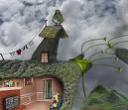
In under a week I am off to Scotland and England as a result of receiving a 2008 Premier’s English Scholarship. The Premier’s Teaching Scholarships are an initiative of the NSW Government where teachers have the opportunity to undertake further professional development that will benefit them, and most importantly their students. Teachers selected to receive a scholarship can undertake international study tours and visit some of the world’s best schools and centres of education to expand their knowledge and understanding.
My scholarship area is developing a “games literacy” framework to facilitate writing development through creative use of computer games in the writing classroom K to 12.
The Annual Speak Up Survey conducted in the USA at the end of 2007 revealed the following information. Students indicated:
- 64% K to 12 play games approximately 8 to 10 hours per week.
- over 50% would like to see educational gaming included in the school curriculum.
Teachers revealed:
- over 50% would like to learn more about integrating computer games into the curriculum
- 46% of those would like to see some form of professional development in the use of games.
- Only 11% were currently using games in instruction.
From this survey two pieces of information are significant:
1. Students want computer games to become part of their school curriculum.
2. Teachers acknowledge computer games need to be integrated into the school curriculum and they need professional development to help make this happen
At my school (Belmore South Public School) computer games are used from Kindergarten onwards. We have found computer games combined with quality teaching practices provide an effective scaffold for working and playing with the language of narrative. Around 95% of our students come from Non English Speaking and socio-economically disadvantaged backgrounds, these students do not need to have control over the entire narrative, they can focus on the language, vocabulary, and sentence structures of different episodes within the game and begin to manipulate, experiment and reflect upon their use of language. The result is students’ language skills have developed as has their desire and ability to effectively communicate their thoughts and feelings.
Digital technologies have impacted on the types of texts our students are interacting with on a daily basis. Our students engage with computer and console games, the internet, instant messaging, texting, and social networking sites. It has been said that our students “power down” when they enter the classroom because of the disparity between what is taught, and how it is taught, inside and outside the school.
The use of computer games in the classroom has a positive effect on the students because of the cultural relevance they provide. Computer games are meaningful and experiential. Students are a part of the game, they have control of the game and a say in what happens. They are motivated and challenged by the computer game and by the story that is an integral part of the game. The opportunity is here to embrace this positiveness and use computer games to support and enhance literacy learning and provide all the elements of quality teaching,
“When we teach creatively with emergent tools in mind, we stand a better chance of engaging reluctant students by giving what we teach real meaning. Each day is an invitation to examine, play, invent, reinvent, and join in the conversation. “Sarah Kajder (2008) ASCD: Educational Leadership: Reaching the Reluctant Learner
Image: ‘Northern Australia‘
www.flickr.com/photos/13066221@N03/2229751363
 When there is a strong vision and plan for a school, which has been discussed and negotiated with the school community and actively embraced by the staff, all staff are able to proceed in their roles with confidence. When this process is led by the Principal who encourages teacher leadership at all levels, having and using this school plan is very important in providing the structures and scaffolds necessary for the freedom entrusted to staff.
When there is a strong vision and plan for a school, which has been discussed and negotiated with the school community and actively embraced by the staff, all staff are able to proceed in their roles with confidence. When this process is led by the Principal who encourages teacher leadership at all levels, having and using this school plan is very important in providing the structures and scaffolds necessary for the freedom entrusted to staff.



 Anna, Gail & Jonathon @ lunch!
Anna, Gail & Jonathon @ lunch!






